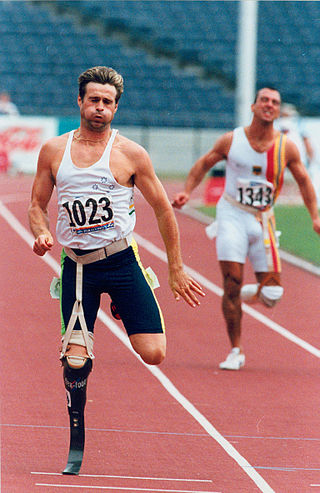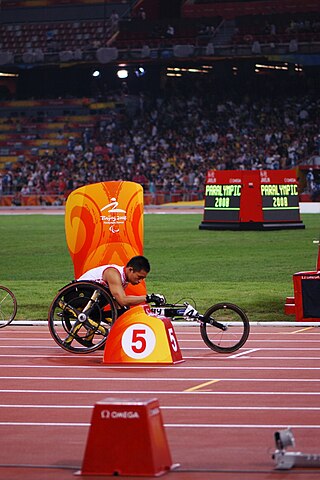
The 2011 IPC Athletics World Championships was held in Christchurch, New Zealand from January 21 to 30, 2011. Athletes with disabilities competed, and the Championships were a qualifying event for the London 2012 Paralympic Games.
The men's discus throw at the 2011 IPC Athletics World Championships was held at the QEII Stadium from 22 to 28 January.
The women's discus throw at the 2011 IPC Athletics World Championships was held at the QEII Stadium on 22-23, 25 and 29 January.
Wu Qing is a Paralympic athlete from China competing in throwing events in the F36 cerebral palsy classification. As of April 2014, Wu holds F36 World Records for shot put, discus and javelin.
Wang Jun is a Paralympian athlete from China competing mainly in throwing events. She competes in the F35 classification.

Katherine Proudfoot is a cerebral palsy athlete from Australia competing mainly in throwing events. She competed in the F36 classification at the 2008, 2012 and the 2016 Summer Paralympics, winning medals at each Game. Following a medical review request in early 2017, she now competes in seated throws in the F32 classification. At the 2017 Australian Athletics Championships she threw 7.04m in the Women's Shot Put Secured event, bettering the Women's F32 shot put world record mark of 6.55m.
Wang Wenbo is a Paralympic athlete from China. He competes in standing throwing events, in the F36 classification for athletes with cerebral palsy. He was a former discus world record holder in his class.
T35 is a disability sport classification for disability athletics' running competitions. It includes people who have coordination impairments such as hypertonia, ataxia and athetosis. This includes people with cerebral palsy. The classification is used at the Paralympic Games. The corresponding F35 classification includes club and discus throw, shot put, and javelin.

T44 is a disability sport classification for disability athletics, applying to "Single below knee amputation or an athlete who can walk with moderately reduced function in one or both legs." It includes ISOD A4 and A9 classes.
T52 is disability sport classification for disability athletics. People in this class have good shoulder and upper body control, but lack fine motor skills in their arms and hands. They have no to limited trunk and leg function. The class includes people with a number of different types of disabilities including spinal cord injuries. Similar classifications are T51, T53 and T54.

T53 is disability sport classification for disability athletics. The class includes people with a number of different types of disabilities including spinal cord injuries. People in this class have full use of their arms but have no or limited trunk function. Similar classifications are T51, T52, and T54. People in this class have a functional upper limbs, but limited trunk usage and limited lower limb functionality. During classification, they both undergo a bench test of muscle strength and demonstrate their skills in athletics. People in this class include Tanni Grey-Thompson (GBR), Samantha Kinghorn (GBR), Angie Ballard (AUS) and Richard Colman (AUS).
The club throw is an athletic throwing event where the objective is to throw a wooden club. The event is one of the four throwing events, along with discus, javelin and shot put of the Summer Paralympics. It is the Paralympic equivalent of the hammer throw. The club throw was introduced for both men and women at the first 1960 Summer Paralympic Games. It was dropped from the women's programme from the 1992 Paralympics in Barcelona but was reinstated for London 2012.
Mariia Pomazan is a Ukrainian Paralympic athlete. She competes in throwing events in the F35 classification for athletes with cerebral palsy. As of April 2014, she held the Women's F35 world records for shot put and discus.
Mohsen Kaedi is a para-athlete from Iran competing mainly in category F34 throwing events. He has competed at two Summer Paralympics, winning a gold medal in the F33–34 javelin at the 2012 Games in London.
F57 is a disability sport classification for disability athletics for people who compete in field events from a seated position. This class is for people with limb deficiencies not covered by other classes. It includes people who are members of the ISOD A1 and A9 classes. Events open to people in this class include the shot put, discus and javelin.
F55 is a disability sport classification for disability athletics for people who compete in field events from a seated position. Sportspeople in this class have full arm function, partial trunk function and no lower limb function. Different disability groups compete in this class, including people with spinal cord injuries. The classification was previously known as lower 3, upper 4.
F4, also T4 and SP4, is a wheelchair sport classification that corresponds to the neurological level T1- T7. Historically, it was known as 1C Incomplete, 2 Complete, or Upper 3 Complete. People in this class have normal upper limb function, and functional issues with muscles below the nipple line.
F6, also SP6, is a wheelchair sport classification that corresponds to the neurological level L2 - L5. Historically, this class has been known as Lower 4, Upper 5. People in this class have good sitting balance, and good forward and backward movement of their trunk. They have some use of their thighs and can press their knees together.
F8, also SP8, is a standing wheelchair sport classification open to people with spinal cord injuries, with inclusion based on a functional classification on a points system for lower limb functionality. Sportspeople in this class need to have less than 70 points. The class has largely been used in Australia and the United States. F8 has largely been eliminated because of a perceived lack of need internationally for a standing wheelchair class. Sports this class participates in include athletics, swimming and wheelchair basketball. In athletics, participation is mostly in field events.
The Oceania Para Athletics Championships is an event organized by Oceania Athletics (OAA) and the Oceania Paralympic Committee (OPC) for athletes with disabilities from the Oceania region. Sanctioned by the OAA and OPC, the event adheres to the rules and regulations set forth by the International Paralympic Committee (IPC) and World Para Athletics.











